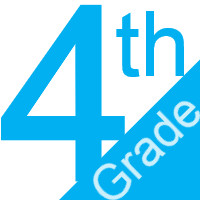4th Grade English
 Standards Glossaries
Standards Glossaries
| K Grade English | 1st Grade English | 2nd Grade English |
 Standards Glossaries
Standards Glossaries
| 3rd Grade English | 4th Grade English | 5th Grade English |
 Standards Glossaries
Standards Glossaries
| 6th Grade English | 7th Grade English | 8th Grade English |
 Standards Glossaries
Standards Glossaries
| 9th Grade English | 10th Grade English | 11th Grade English | 12th Grade English |
 Standards Glossaries
Standards Glossaries
| HS Journalism | HS Speech |
| (SL) Speaking and Listening |
ELA-04.SL.01
ELA-04.SL.01 Engage effectively in a range of collaborative discussions (one-on-one, in groups, and teacher-led) with diverse partners on grade 4 topics and texts, building on others’ ideas and expressing their own clearly.
a. Come to discussions prepared, having read or studied required material; explicitly draw on that preparation and other information known about the topic to explore ideas under discussion.
b. Follow agreed-upon rules for discussions and carry out assigned roles. c. Pose and respond to specific questions to clarify or follow up on information, and make comments that contribute to the discussion and link to the remarks of others d. Review the key ideas expressed and explain their own ideas and understanding in light of the discussion. | |
ELA-04.SL.02
ELA-04.SL.02 Paraphrase portions of a text read aloud or information presented in diverse media and formats, including visually, quantitatively, and orally.Student Learning Targets:Knowledge Targets
Reasoning Targets
Skills (Performance) Targets
Proficiency ScaleThe student can ...1 Beginning... with help, demonstrates a partial understanding of some of the simpler details and processes (Score 2.0 content) and some of the more complex ideas and processes (Score 3.0 content)... give a few key details from a story read aloud or from information presented orally. 2 Developing... demonstrates no major errors or omissions regarding the simpler details and processes but exhibits major errors or omissions regarding the more complex ideas and processes (Score 3.0 content).... paraphrase most of the information from a read aloud or from information presented orally. 3 Proficient“The Standard.”... demonstrates no major errors or omissions regarding any of the information and processes that were end of instruction expectations. ... paraphrase information from a story read aloud or from information presented orally 4 Advanced... demonstrates in-depth inferences and applications regarding more complex material that go beyond end of instruction expectations.... paraphrase the information from an advanced story read aloud or from sophisticated information presented orally. ResourcesVocabulary
Websites
| |||
ELA-04.SL.03
ELA-04.SL.03 Identify the reasons and evidence a speaker provides to support particular points.Student Learning Targets:Knowledge Targets
Reasoning Targets
Skills (Performance) Targets
Proficiency ScaleThe student can ...1 Beginning... with help, demonstrates a partial understanding of some of the simpler details and processes (Score 2.0 content) and some of the more complex ideas and processes (Score 3.0 content).Start 2 Developing... demonstrates no major errors or omissions regarding the simpler details and processes but exhibits major errors or omissions regarding the more complex ideas and processes (Score 3.0 content).Simple 3 Proficient“The Standard.”... demonstrates no major errors or omissions regarding any of the information and processes that were end of instruction expectations. Target 4 Advanced... demonstrates in-depth inferences and applications regarding more complex material that go beyond end of instruction expectations.Complex ResourcesVocabulary
Websites
| |||
ELA-04.SL.04
ELA-04.SL.04 Report on a topic or text, tell a story, or recount an experience in an organized manner, using appropriate facts and relevant, descriptive details to support main ideas or themes; speak clearly at an understandable pace.Student Learning Targets:Knowledge Targets
Reasoning Targets
Skills (Performance) Targets
Proficiency ScaleThe student can ...1 Beginning... with help, demonstrates a partial understanding of some of the simpler details and processes (Score 2.0 content) and some of the more complex ideas and processes (Score 3.0 content).Start 2 Developing... demonstrates no major errors or omissions regarding the simpler details and processes but exhibits major errors or omissions regarding the more complex ideas and processes (Score 3.0 content).Simple 3 Proficient“The Standard.”... demonstrates no major errors or omissions regarding any of the information and processes that were end of instruction expectations. Target 4 Advanced... demonstrates in-depth inferences and applications regarding more complex material that go beyond end of instruction expectations.Complex ResourcesVocabulary
Websites
| |||
ELA-04.SL.05
ELA-04.SL.05 Add audio recordings and visual displays to presentations when appropriate to enhance the development of main ideas or themes.Student Learning Targets:Knowledge Targets
Reasoning Targets
Skills (Performance) Targets
Proficiency ScaleThe student can ...1 Beginning... with help, demonstrates a partial understanding of some of the simpler details and processes (Score 2.0 content) and some of the more complex ideas and processes (Score 3.0 content).Start 2 Developing... demonstrates no major errors or omissions regarding the simpler details and processes but exhibits major errors or omissions regarding the more complex ideas and processes (Score 3.0 content).Simple 3 Proficient“The Standard.”... demonstrates no major errors or omissions regarding any of the information and processes that were end of instruction expectations. Target 4 Advanced... demonstrates in-depth inferences and applications regarding more complex material that go beyond end of instruction expectations.Complex ResourcesVocabulary
Websites
| |||
ELA-04.SL.06
ELA-04.SL.06 Differentiate between contexts that call for formal English (e.g., presenting ideas) and situations where informal discourse is appropriate (e.g., small-group discussion); use formal English when appropriate to task and situation.Student Learning Targets:Knowledge Targets
Reasoning Targets
Skills (Performance) Targets
Proficiency ScaleThe student can ...1 Beginning... with help, demonstrates a partial understanding of some of the simpler details and processes (Score 2.0 content) and some of the more complex ideas and processes (Score 3.0 content).Start 2 Developing... demonstrates no major errors or omissions regarding the simpler details and processes but exhibits major errors or omissions regarding the more complex ideas and processes (Score 3.0 content).Simple 3 Proficient“The Standard.”... demonstrates no major errors or omissions regarding any of the information and processes that were end of instruction expectations. Target 4 Advanced... demonstrates in-depth inferences and applications regarding more complex material that go beyond end of instruction expectations.Complex ResourcesVocabulary
Websites
| |||



 Grade 4
Grade 4